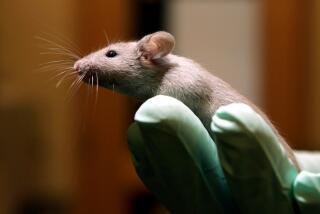Research Boon Seen in AIDS-Susceptible Mice : Disease: Development of genetically altered rodents means inexpensive and rapid testing of new drugs and therapies. Studies to date have relied on costly primates.
- Share via
More than a decade into the search for a laboratory animal that develops AIDS in the same way humans do, two sets of California researchers say they have found one: a genetically altered mouse implanted with human immune cells.
Their work, published today in separate articles in the journal Nature, means that scientists may have an inexpensive and rapid way to test new drugs and therapies for AIDS with some confidence that the same results would occur in humans.
“This is an important milestone toward development and testing of AIDS therapies,” said Jerome Zack, a UCLA virologist who was the principal investigator on one of the studies. “We now have an old animal model with a new twist.”
Most AIDS animal experiments rely on primates. Rhesus macaque monkeys are frequently used, but they are expensive to purchase and care for, and they only contract the simian immunodeficiency virus--a cousin to the human immunodeficiency virus that causes AIDS. Moreover, macaques take six months to a year to develop the disease after being infected--a time lag that means testing can be slow.
Chimpanzees are able to contract the human AIDS virus, but they too are expensive and even when infected they do not develop the disease. Normal mice cannot be used because they are not susceptible to infection.
By contrast, the new studies by Zack and researchers at SyStemix Inc., a Palo Alto company, show that the virus destroys the immune systems of the genetically altered rodents as quickly as six weeks after infection. At a cost of about $250 apiece, Zack said, the mice are one-tenth the price of primates.
The mice were developed six years ago and tested at length by immunologist J. Michael McCune, then a Stanford University professor, and several of his colleagues who went on to found SyStemix. The rodents’ own immune systems are removed and replaced with tissue from the thymus, the gland that manufactures T-cells, the immune cells that are the main targets of HIV.
The thought behind creating the mice, McCune said, was “to take the organ systems that can be infected by HIV in humans--the very organs that you’d like to study but can’t study in humans--and transplant them into the mouse.”
The SyStemix group has since shown that the mice can be infected by HIV and that the infection could be blocked by the anti-viral drug AZT. The new studies from SyStemix and UCLA document, for the first time, the development of the disease in the mice.
The studies show that HIV vigorously attacks the thymus, destroying T-cells very early in their development, before they have matured. The results suggest that the AIDS virus not only destroys immune cells but also hampers the body’s ability to produce them.
Zack said the path of destruction is similar to what has been seen in studies of aborted fetuses that have been infected with HIV, which leads the researchers to believe that what is happening in the mice mimics what happens in humans.
However, there are limitations to what the mice can teach scientists about the way HIV works. Humans have a complicated immune system with more components than the thymus gland alone. Thus, the mice cannot provide a complete picture of how the virus attacks the body, said Anthony Fauci, the government’s top AIDS expert.
Fauci uses the mice in his own research and reported results similar to the California studies two weeks ago at the International AIDS Conference in Berlin.
“It has some limitations,” he said, “but it can be very useful in the testing of drugs because you can directly measure the effect of a certain drug by seeing if it blocks the spread of infection through the thymus gland.”
* AZT GUIDELINES: Researchers ponder AZT guidelines after study casts doubt on when to use it. A10





